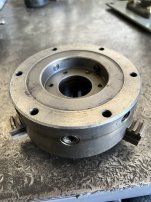I’m designing a custom set tru backplate for a worn out 6”, 3 jaw, Buck chuck that was given to me. Since this is for a manual welding rotary positioner, normal lathe precision is appreciated but not required. The receiver/socket (itself) in the back of the chuck has an ID of 3-1/8”. When I fully retract one adjusting screw and fully extend the opposing one, the receiver/socket would accept at most a 3” diameter hub. I can envision locking screw (thru holes in the chuck) problems selecting a hub diameter of 3”. I can envision lack of adjustment if I choose a diameter of 3-1/8”. Unfortunately I lack the experience to know if any of these outcomes are real. Are there any guidelines or practices for choosing the hub diameter? Shoot for the middle: 3-1/16”? Are there any other failure scenarios I should be aware of when choosing the hub diameter?
How to install the app on iOS
Follow along with the video below to see how to install our site as a web app on your home screen.
Note: This feature may not be available in some browsers.
You are using an out of date browser. It may not display this or other websites correctly.
You should upgrade or use an alternative browser.
You should upgrade or use an alternative browser.
Set Tru Chuck Backplate Design
- Thread starter 4thTool
- Start date
- Replies 10
- Views 902
TGTool
Titanium
- Joined
- Sep 22, 2006
- Location
- Stillwater, Oklahoma
Usually limited by the amount of slack between the bolts and holes holding the chuck to the backplate. If you have clearance holes 1/32" larger than the bolt that implies roughly .03" total movement. The bolts could be rolled threads, in which case the body diameter is smaller than nominal, and of course you can drill clearance holes to a larger oversize.
Gordon Heaton
Titanium
- Joined
- Feb 19, 2007
- Location
- St. George, Utah
For a welding positioner I'd just mount it up and go to work. If it runs out at 1/16" who cares?
wesg
Titanium
- Joined
- Nov 4, 2004
Use the outer screws? Yeah, needs a bigger piece of stock.
guythatbrews
Titanium
- Joined
- Dec 14, 2017
- Location
- MO, USA
Leave .04 clearance on the hub and use bolt holes 1/32 oversize. You can always turn down the bolts to the minor diameter.
Or just use a flat backplate. Tap into true and tighten the bolts. There is little to no radial force on your application so you don't need the hub for the true screws to push on.
Or just use a flat backplate. Tap into true and tighten the bolts. There is little to no radial force on your application so you don't need the hub for the true screws to push on.
stephen thomas
Diamond
- Joined
- Jun 3, 2001
Another thing to consider - with a worn chuck, the adjustru feature is useful if you need very close setting per piece - grab the part and move the chuck until it runs true. However, it probably won't repeat closer than a "few" .001's. Basically the worn jaws and scroll will hunt. So it is only true each time you adjust it.
Again, i think it is useful to include the feature - use it when you need it. Ignore it when you don't. But don't count on it making the chuck itself a routine .0001 repeater.
smt
Again, i think it is useful to include the feature - use it when you need it. Ignore it when you don't. But don't count on it making the chuck itself a routine .0001 repeater.

smt
Gordon Heaton
Titanium
- Joined
- Feb 19, 2007
- Location
- St. George, Utah
He's using it for a welding positioner.... . .don't count on it making the chuck itself a routine .0001 repeater.
stephen thomas
Diamond
- Joined
- Jun 3, 2001
He's using it for a welding positioner...
yeah, that is what he posted.

But if he is trying to add adjustru feature, he must have some need for occasionally bumping the work to something in the somewhat precise range.
My point is "good thinking ahead of time for when you need it" But "just don't count on it being good on the second part because you set it up on the first" When needed, it will best be indicated every darn part afterall.
smt
Since this is for a manual welding rotary positioner, normal lathe precision is appreciated but not required.
You don't need to adjust the concentricity. Even a worn out chuck should run within .125"
Similar threads
- Replies
- 3
- Views
- 168


